Merlin the Madman
Merlin, Mad Sweeney and the Lost Pagans
“The best thing for being sad," replied Merlin, beginning to puff and blow, "is to learn something. That's the only thing that never fails. You may grow old and trembling in your anatomies, you may lie awake at night listening to the disorder of your veins, you may miss your only love, you may see the world about you devastated by evil lunatics, or know your honour trampled in the sewers of baser minds. There is only one thing for it then — to learn. Learn why the world wags and what wags it. That is the only thing which the mind can never exhaust, never alienate, never be tortured by, never fear or distrust, and never dream of regretting. Learning is the only thing for you. Look what a lot of things there are to learn.”
― T.H. White, The Once and Future King
Hello Reader, thank you for taking the time to read my blog! It takes days to research and write and it’s all for FREE! Why? Because I love it. I don’t ask anyone to subscribe, we have enough bills in this strange world. Why not buy the author a coffee, and make her day? Thank you!
Children in the 1970s used to play games you could be hung for, today. Cowboys and Indians. Knights and Damsels. There is a picture of me with my cousin Colin from New York in the back yard of the house in plastic armoury emblazoned with a golden lion. But he even had chainmail. I had a strange witch outfit mostly pulled out of my mother’s wardrobe, apart from a homemade black coned witches hat that I made myself. I had grabbed my mother’s washing up brush for the photo and used it as a wand. Anyway I remember being thrilled with the whole thing. I used to play in the woods in Enniskerry with my first friend in the world, D. Her father gave us a real cauldron from his stock of old antiques, and off we went into the woods with it and brewed up spells. There seemed to be a little concrete hut in the middle of the woods, and D put all her potions in here. We never watched television, I didn’t even have one at home. It was a game that only ended really when we took the 44 bus into Dublin, found Grafton Street and became ferile Cureheads overnight, replete with laddered tights and lashings of black eyeliner and secret hipflasks of gin from our parent’s drinking cabinets.
So we were witches but who was the wizard? We didn’t really have one, but I was aware that there could be a wizard, beause I had seen Disney’s Sword in the Stone. It would never impact me in the way that T.H.White’s The Sword in the Stone did.
In the book, Merlin says a lot of things to Wart, the orphan boy raised by Sir Ector in Castle Sauvage. Wart is a knight in training and it seemed his common birth determined he would become Sir Ector’s son Kay’s squire. The real mentor for Wart is Merlin, who he meets in the Forest while hunting with a tiercel goshawk. Merlin knows very well who Wart is, because he’s been watching him since his birth, knowning his destiny- that he would become the King to unite the land- King Arthur.

White reimagines the Arthurian tale and uses the Wart-Merlin relationship to explore everything he can about sociology, the horrors of war, colonialism, man’s relationship to the natural world. Merlin’s mind encompasses the past and the future, and he lives backwards. So he pretty much knows everything. Through little parables, Wart is turned into different creatures of the forst, but mixed in with this is White’s slightly pedantic views on imperialism and the likes of the Welsh, Scottish and Irish. Scratching his chin, he says to Wart, in the middle of a rant about the Norman Conquest:
"I never could stomach these nationalists," he exclaimed. "The destiny of Man is to unite, not to divide. If you keep on dividing you end up as a collection of monkeys throwing nuts at each other out of separate trees.”
I’ve said a lot about this in my blog, Exile in Ireland.
Exile in Ireland
A LITTLE NOTE BEFORE YOU GO INTO THE FASCINATING STORIES OF TROUBLED WRITERS THAT CROSSED THE TROUBLED WATERS OF IRELAND (WHETHER COMING OR GOING)….. Here in this blog, there are things revealed that nobody has seen or read before. Even I didn’t know about White and my grandfather, ‘til I rummag…
White even talks about the IRA in The Sword in the Stone. I don’t know how he got away with hijacking his characters in the way that he did to convey his own ideas and in his own timeline but he did. He lived in Ireland during World War Two to avoid conscription, and wrote The Sword in the Stone here, and reaped the benefits of its success here. It was this book that catapulted him into Hollywood, and it was later work of this that was adopted into the musical- film with Vanessa Redgrave and Richard Harris. Camelot which might have been the making of him, if he had not spiralled into depression and alchololism. He was 57 when he was found dead in his cabin during a Meditteranean cruise.
But back to Merlin and his Otherworldly Sight. White's Merlyn seeks to educate Arthur about the concepts of "Might and Right" and the horrors of war by changing him into a variety of different animals. When humans can coexist with creatures of the natural world, Merlyn explains to Arthur, they will finally solve the problems of their own species:
"the imaginary lines on the earth's surface ... [that] the airborne birds [skip] them by nature ... [would disappear] for Man if he could learn to fly" - The Once and Future King , p.639)

Merlin’s sight is extraordinary and seering not just of the physical world, but of the hidden worlds between dreams and reality, between the future and the past. He has what Geoffrey Ashe called ‘a multiplicity of vision’.
Merlin forms a link between the worlds during the so-called Dark Ages. He might have cast a ray of hope. In White's The Once and Future King, Merlin is unable to exist properly in the present, and is the social visionary, the messenger of fate. He tips Wart into that edge between the human and the natural world where they can mingle, and find themselves outside of themselves, in the rhthym of the natural world.
Who, and what is this Merlin? In Brythonic, he was Myrddin, the bard. Geoffrey of Monmouth, the 12th Century chronicler and chief propagandist for the Plantagenets, apparently latinised Myrddin to Merlinus instead of Merdinus, because that meant, in Anglo-Norman, quite simply, ‘poo’. Merlin could also be merle, French for blackbird. Or Merlinus could be a euphony of Myrddin, to be brought closer to the Latin for blackbird, ‘Merle’, in to which Merlin could of course metamorphose, among many other creatures. The Welsh Merlin comes from the old Brythonic name, “Myrddin.” Whereas the name “Merlin” in the case of the birds is derived from the old French word “esmerillon,” which was the old French name for this species. Thus, Merlin the wizard and Merlin the bird are connected only by name. Still, it isn’t too hard to connect Merlin hawks with magic, wisdom, foresight, or the supernatural.
“An Eagle for an Emperor, a Gyrfalcon for a King; a Peregrine for a Prince, a Saker for a Knight, a Merlin for a Lady; a Goshawk for a Yeoman, a Sparrowhawk for a Priest, a Musket for a Holy water Clerk, a Kestrel for a Knave.”— The Book of Saint Albans c. 1486

The original story of Merlin as we know it (if there is an original in tact), comes from Geoffrey of Monmouth’s ‘History of the Kings of Britain’. (Historia regum Britanniae- 1135). He seems to have adapted a story told by the Welsh antiquary Nennius (c. 800), of a boy, Ambrosius (the name was ‘stolen’ from a previous, historical, heroic King) In Geoffrey’s account Merlin-Ambrosius figured as adviser to Uther Pendragon (King Arthur’s father) and afterward to Arthur himself. In a later work, Vita Merlini, Geoffrey further developed the story of Merlin by adapting a northern legend about a wild man of the woods, gifted with powers of divination.
The account takes place in the 5th Century, when a Welsh King called Vortigern, under siege by the Saxons, fled to Wales to build a fortress, but every time he tried the stone walls shook to the ground. The King was told that the sacrifice of a fatherless boy would keep the walls holding strong for his fortress. That was a done thing in those days. His retinue searched for such a boy and found one in the woods, who lived alone, shunned for having no father. His mother told the King’s men that she had been impregnated by a demonic spirit. The boy’s name was Merlin Ambrosius.
They brought Merlin to the fort and as the sacrficial priest came to do his deed, Merlin scorned him, and told them all that if they dug there, they would find an underground pool, and within it two stone jars when it was drained. They found the pool, drained it. The jars where there, out flew two dragons from them one red, one white. They flew out of the jars and raced across the sky. The red dragon chased the white dragon away…. the King shuddered.
Merlin stood up and proclaimed his first prophecy, that the red dragon was Britain, and that the white dragon was the invader. Merlin grew into his full powers from this time, performed great deeds. He used his great horn to transport giant rocks from Ireland, and built the stones in a circle at Stonehenge..

There was another King who asked Merlin to put a spell for him on the woman he loved, and Merlin agreed, on condition that he would take the child born of that tryst, and that was the future King Arthur. Merlin raised the boy in the Welsh countryside, and Arthur’s father died and chaos spread through the land. That was when Merlin came up with the idea of the test for the ‘Once and Future King’. The one destined to be king could draw the sword from the stone. Arthur did so, at 15 years old. Twenty years of peace followed for Arthur and his gallant knights, the golden age of Camelot. Merlin was Arthur’s prophet and sage. He ignored Merlin’s warning however about Guinevere, who would betray him but in any case Merlin predicted the Knights would bring great honour. He was no lover of pomp of the court, and there he took the forms of birds and animals in the night. His end was this… he did not die, but was trapped by a beautiful nymph in a hawthorn tree…

Wherever Merlin appeared, all were amazed at his knowledge and it was known that he was in some way supernatural. Geoffrey of Monmouth’s account of Merlin in the History of the Kings of Britain was perhaps the stuff of legends, however. Or was it? Because the places all exist, that he mentions in the text. Caerfyrddin, the City of Merlin, exists. That is where Merlin was found by the King’s scouts. Dinas Emrys, in the heart of Snowdonia, is the hill where dragons emerged from the hidden pool, and a pool lies to this day on the hill. The Red dragon is of course the embelm of Wales. There is a place called Merlin’s Cave…
Geoffrey also wrote Vitae Merlinae, The Life of Merlin (1150) and he seems to have claimed that the Merlin he wrote about in the History of the Kings are one and the same, they just lived in different ages. There could have been two Merlins? Let’s look at the the other Merlin, not the one who was from the 5th century, who soothsayed for King Vortigern, fleeing the Saxons. The ‘other’ Merlin is Myrddin the wild man, who was the prophet-priest-bard for King Gwenddoleu in Scotland. He would have consecrated the King’s sovereignty with a ritual using a white wand, to personify Lugh, the saviour god, ancestor and protecter of the monarchy. The King’s mother, it was believed, had been impregnated by Lugh, much as Merlin’s mother had been impregnated by a demon-god.
But Gwenddoleu was defeated in the battle of Arfderydd in 573 AD, according to the Annales Cambriae. Myrddin went mad after the battle and ran Scotland’s Caledonian Forest where he lived in the wilderness, communed with wildlife, and gained the gift of prophecy. However this fleeing into the forest by a madman is a motif in Celtic folklore, and appears in Brittonic/ Brythonic tale of Lailoken and in our own Buile Shuibhne (The Madness of Sweeney ). More of Mad Sweeney later.

This battle at Arfderydd gives us a great clue to the origins of Merlin, the madman in the forest. The man who is poised, due to his seerlike abilities, between the pagan and the Christian world. For this battle at Arfderydd symbolises the death and end of pagan Scotland and the bard Myrddin’s great grief is for the loss of that pre-Christian world. There in the forest he lamented alone all that he had lost. He had strewn dust on his hair, departed to the woods, lived on roots and grasses, hidden like a wild animal , forgot his kin. Historicial annals of the time do record that battle of Arfderydd, and one of the annals concludes that Gwendoly fell, and Merlin became mad.
Geoffrey Ashe sees Merlin as a real person, a poet who had prophetic gifts, who wandered about giving prophecies in the Scottish borderlands. He was too early to be associated with Arthur. This Myrrdin of the late 6th Century does seem instrinsically connected to Arthur’s Merlin, if only archetypally.
"When Christianity prevailed and Celtic paganism crumbled into mythology, a great [period of transition occurred]. Water and islands retained their magic ... haunted hills became fairy-hills ... unseen realms intersected the visible ... [and] theme by theme the Celtic imagination articulated itself in the story. Yet any given episode might be taken as fact or imagination or religious allegory or all three at once" - Geoffrey Ashe, From Caesar to Arthur
Merlin walked the sad and bleak path of violence in the death of the pagan world. Much like our Mad Sweeney, in Ireland. Sweeney, a 7th Century Ulster King, who, on hearing that Ronan Finn was building a church in his area, assaulted the cleric, hurled his pslater into a nearby lake, and brought upon himself curses that banish him to a life of madness in the trees. In exile, Sweeney abides in a range of roosts across the length and breadth of Ireland as a part-human, part-avian figure.
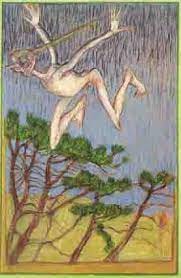
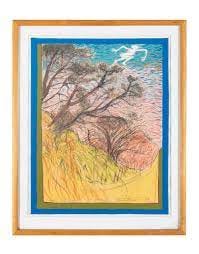

Merlin, too, shapeshifts into a bird and many kinds of bird and animal. Sweeney suffers and laments in the forests, like Merlin. He awaits his death “at spear point”. Ronan’s curse goes on and on. Sweeney resists conversion. He will remain in the trees. But in the end he is taken in by Saint Moling who cares for him in the very church he so vehemently resisted. For, he had become a ‘bird brain among branches’. Ronan’s curse did far more harm than he had anticipated. Apparently. Although Sweeney’s strange migrations and his ultimate surrender into a Saint’s arms seems to be the conculsion of the Christian scribe.
Sweeney, Merlin, Myrrdin, were all living like druids. The druids the Romans pulverised in Britain from 43 AD. The druids that were banished in Ireland. The priests of the Celtic people, the receptacles of oral history and knowledge. They were legal authorities, adjudicators, lorekeepers, medical professionals and political advisors. Hence their decimation. Destroy them, and the lore and wisdom is destroyed with them, because they did not write anything down. It got worse. Their oak groves were destroyed. And in them, their sacred creatures. Their swans, their foxes, their deer. Merlin, too, communicated with these animals. He lamented his plight to a tame wolf, he rode a stag with deer all around him. He was like Cyonnnos, lord of the beasts. He saw the future, he saw the destinies of unborn children. His most famous prophecy was of course of Arthur “men will get drunk on wine, they will forget everything, and will cease to accomplish .. the dust of ancient times will rise up again…’
“It is a pity that there are no big creatures to prey on humanity. If there were enough dragons and rocs, perhaps mankind would turn its might against them. Unfortunately man is preyed upon by microbes, which are too small to be appreciated.”
― T.H. White, The Book of Merlyn: The Unpublished Conclusion to The Once & Future King

It is said in Irish literature that Merlin visited Ireland on the heels of Saint Patrick, who had been busy with converting Ireland to Christianity. Maelduin was depicted as the son of princess who became a nun, rasied in secret and of course his father ‘s identity was a secret. Let us suspect his father was a supernatural being, like Merlin of the Arthurian tales, though his father is identified as being a legendary Irish figure, a king called Ailill, a demigod who lived between this world and the Otherworld of the Tuatha de Dannan. In the Voyage of Maelduin’s Boat, Maelduin/ Merlin sets sail for the Otherworld to find his father.

The Journey of Maelduin/ Máel Dúin, may have been inspired by Ulysses’ or Jason’s wanderings. Imram Curaig Maelduin, the Voyage of Maelduin (possibly 8th Century, though ‘edited’ by Aed the Fair in the 11th Century), is where you will find his story. You might turn your rational nose up at giants, demons and other creatures they encounter, but the places they visited may well have been the Faroe Islands, Greenland and Iceland… and even a forested land that could be Northern Canada. How could they sail that far back then, in a little boat, you might say? Consider the Voyage of Saint Brendan in the 5th Century, a contemporary of Merlin’s, our Brendan the Navigator who voyaged in a coracle to the “isle of the blessed”. His story is written in Brendan of Clonfert (c. AD 484 – c. 577). He is also referred to as Brendan the Navigator, Brendan the Voyager, Brendan the Anchorite, and Brendan the Bold. Naomh Bréanainn or Naomh Breandán. He is mainly known for his legendary voyage to find the “Isle of the Blessed” which is sometimes referred to as “Saint Brendan’s Island”. His story is also written as The Navigatio Sancti Brendani Abbatis (Voyage of Saint Brendan the Abbot) in the Immram.
On Maelduin’s Voyage, they saw many things. There was the sound of a gigantic forge with a giant smith hammering iron on an anvil… the smith came out, holding a red hot iron, hurled it to the boat so that the sea boiled and they fled.
They came across a floating island like a great column bright like silver with four sides, two oar strokes wide, barren, no earth, towering over them with its base below….
On the last island they reach a forested one whre there was a hermit who told them he came from Ireland and he lived alone guarding a stone on which is inscribed a sacred text.
In some versions, Maelduin never returns…
In ‘classical’ Arthurian myth-history, the Grail is needed to cure King Arthur and Merlin sends the Knights of the Round Table on a quest to find it, which it is by the foolish Sir Parcival (foolishness was nurtured by his overprotective mother, and foolishness was required as a quality for being the grail knight. The ‘Innocent’ fool) Parcival was guardian of the holy relic. The mysterious Grail Castle is where Merlin ends his life in Britan before sailing off to Avalon….
The Avalon that Merlin is said to have sailed to might have been an island off the coast of North America, since it could well be that The Voyage of Maelduin's Boat was based on a real Atlantic sea crossing. Who told the tale? The returning crew. To the scribes who wrote it down.
Where did Merlin go? If he went to Avalon, where is that? Some called it Mananan. There is a Manana island off the coast of Maine… Mananan Mac Lír, the Irish god of the Sea..
Or.. could Merlin be in Glastonbury? I saw this fellow outside the Abbey in August..
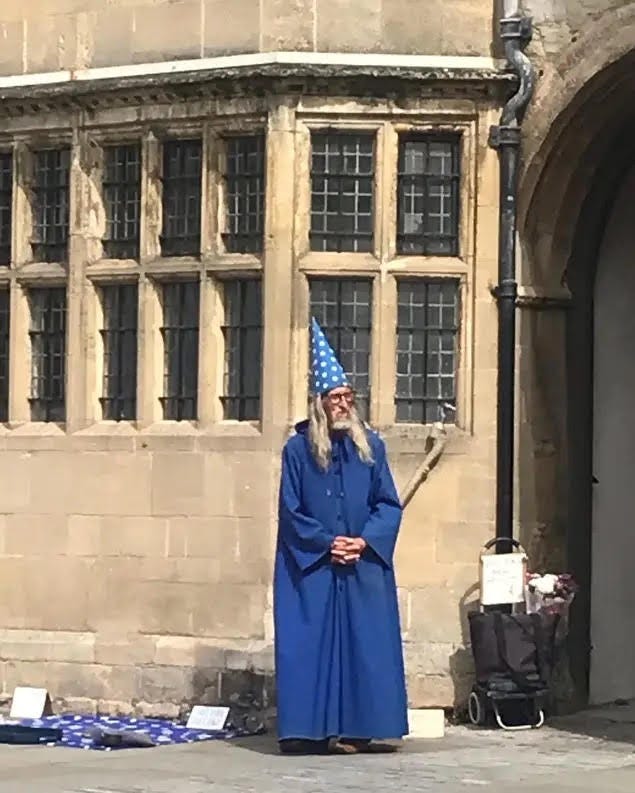
Whatever and whoever Merlin is, wherever he may be, we need him now more than ever. Where are the wise advisors to our leaders? There are none! Bring Merlin Back!
Enjoyed the blog? It takes days to research and write and it’s all for FREE! Why? Because I love it. I don’t ask anyone to subscribe, we have enough bills in this strange world. Why not buy the author a coffee, and make her day? Thank you!



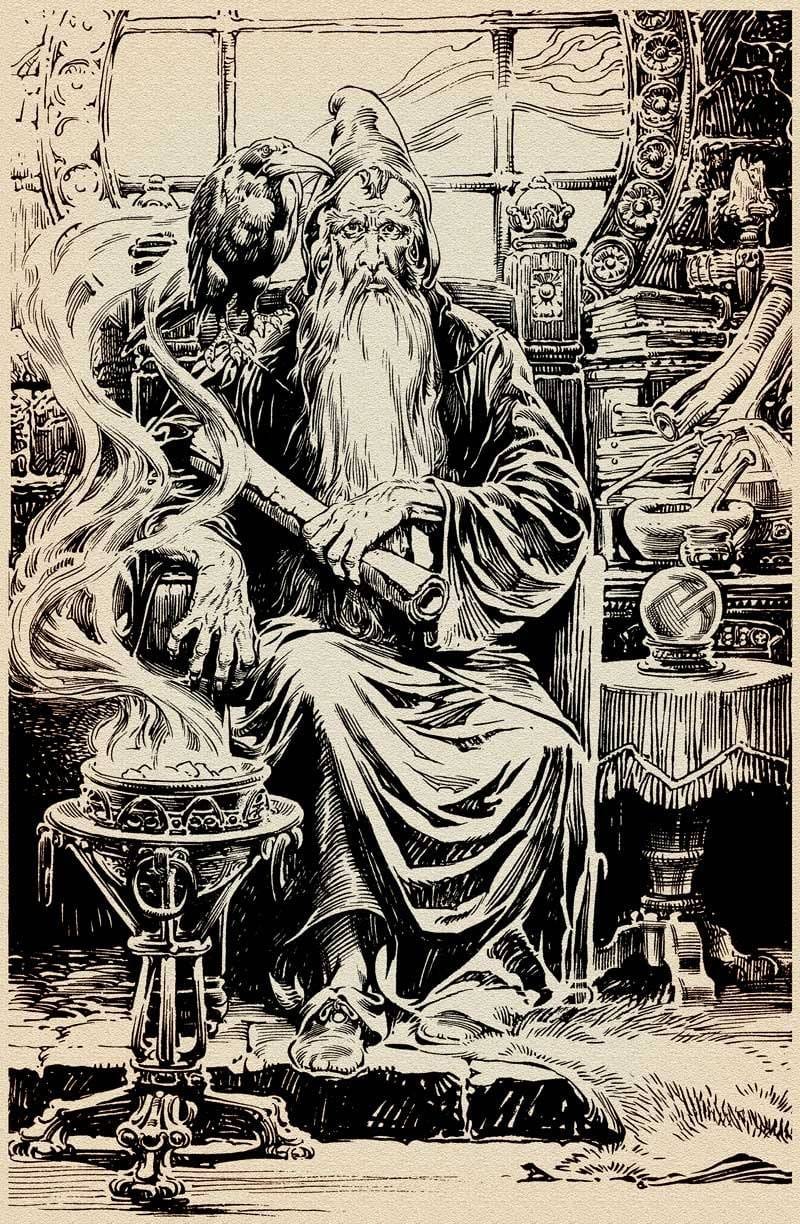
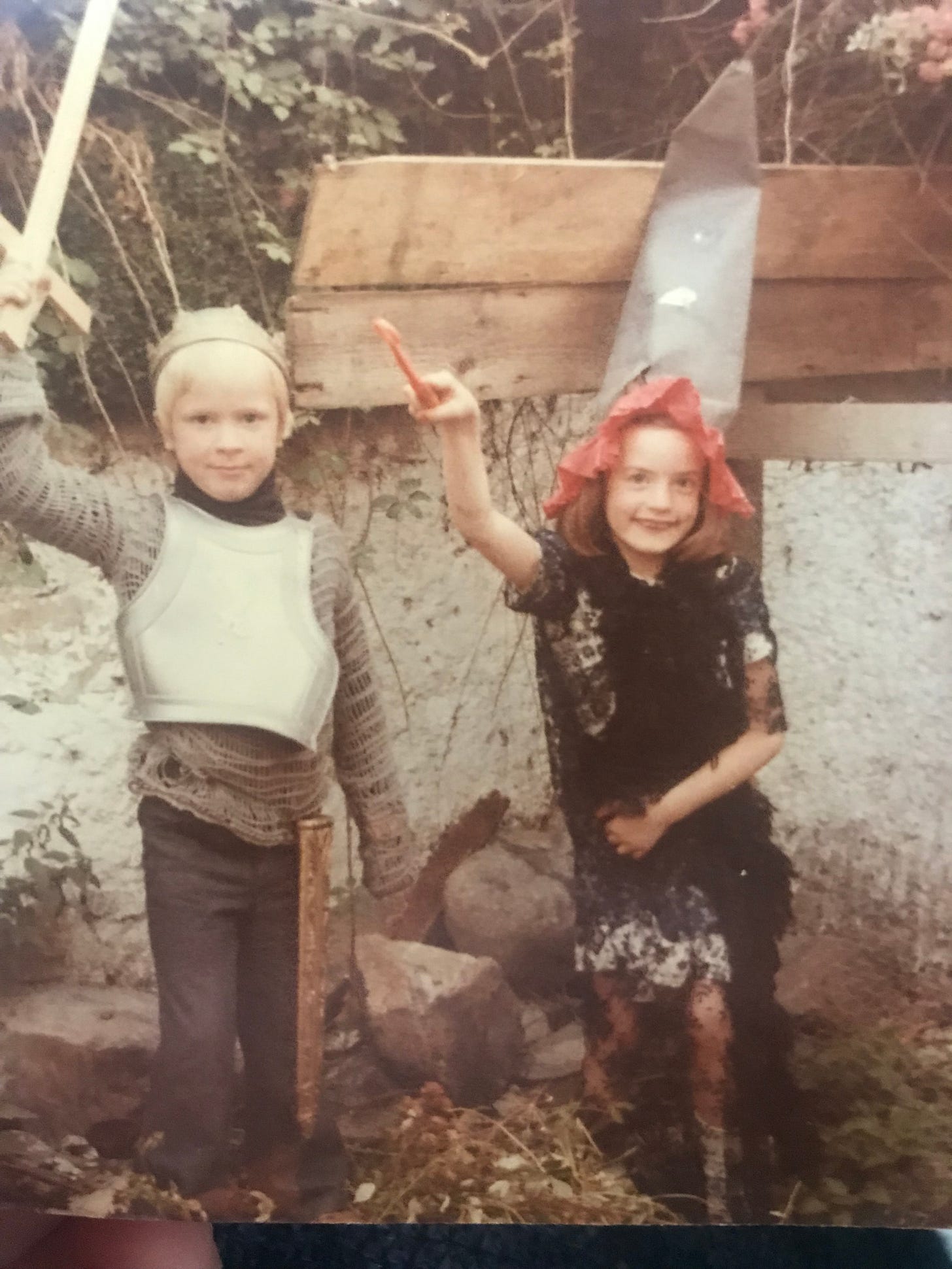
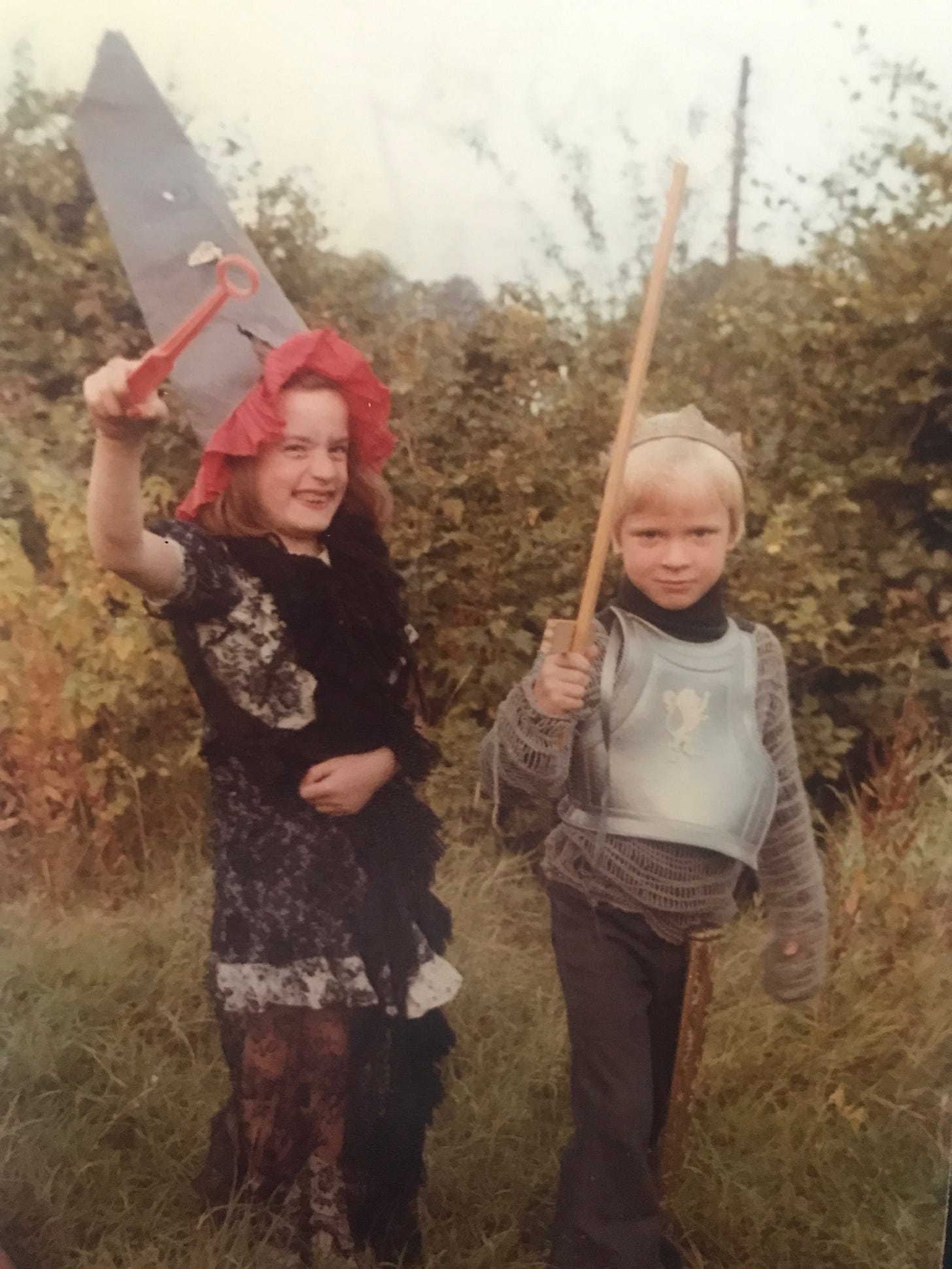
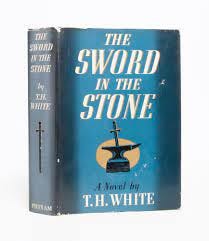
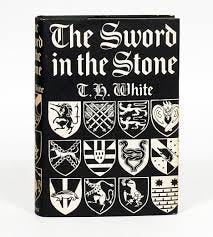

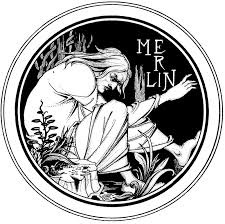


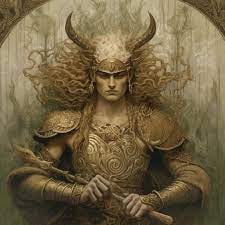
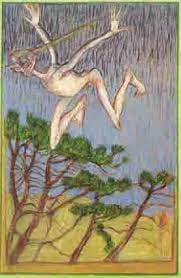
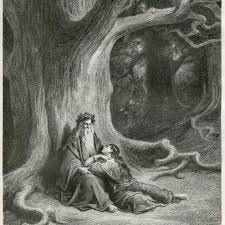
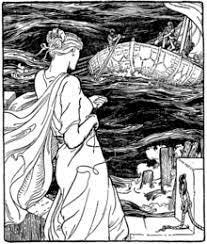
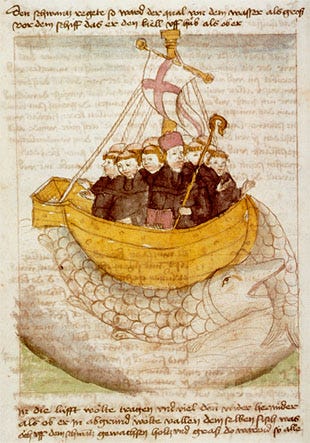

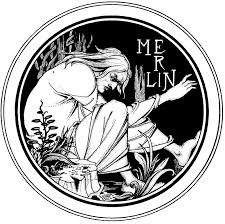
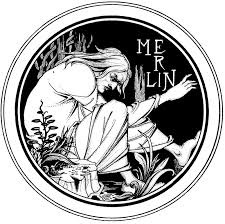
Reading this made my day in this time of one new horror after another. The initial statement in italics roped me in. "There is only one thing for it then — to learn. Learn why the world wags and what wags it" Thanks
Myrddin (Merlin) was a real individual and the evidence for his life is fairly conclusive. The 'son of the Devil (Pagan) and servant of God (Christianity)' being also the first recorded case I am aware of concerning PTS from the horrors of battle only makes his humanity very real. Another great read. Thanks.